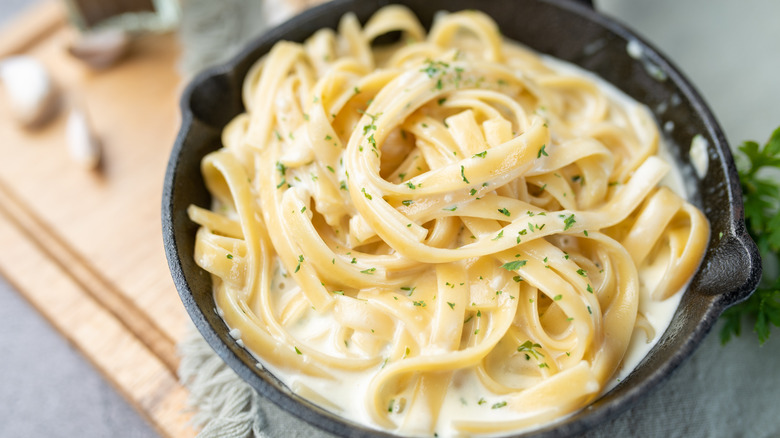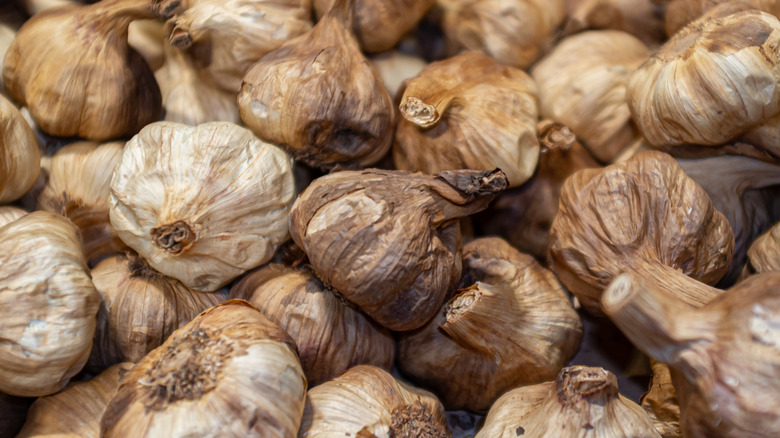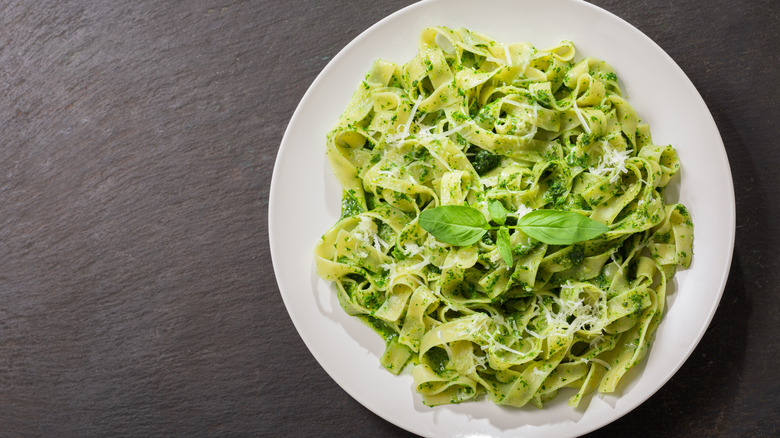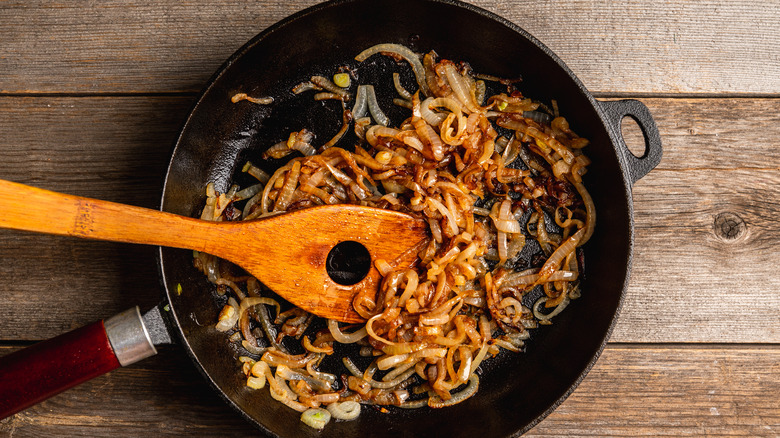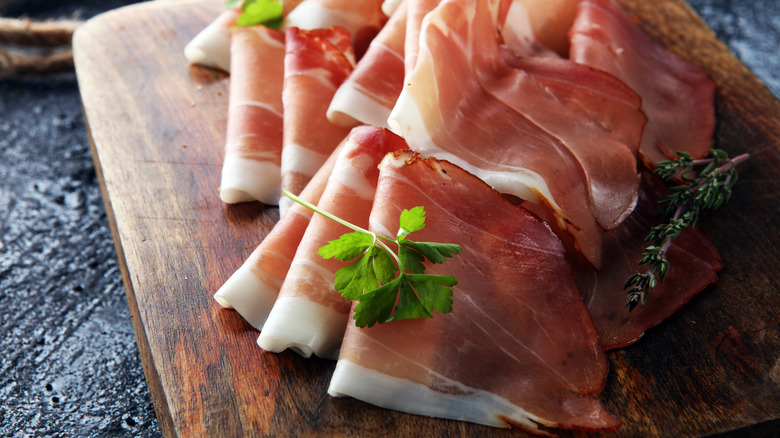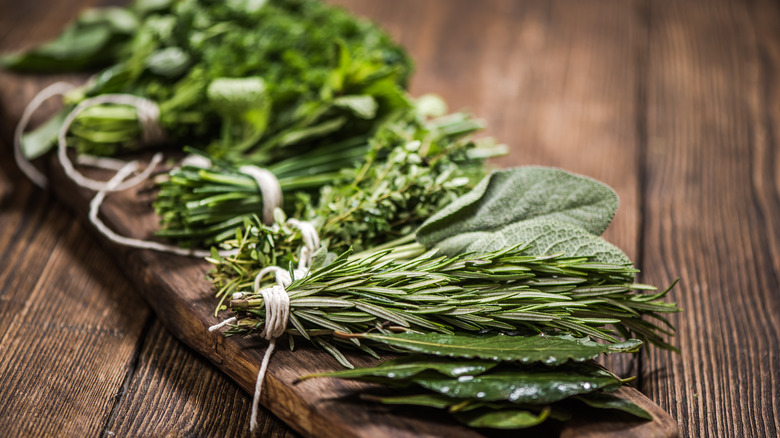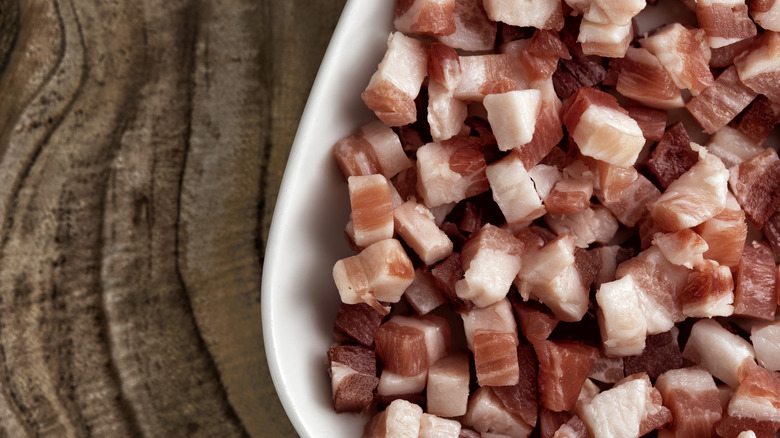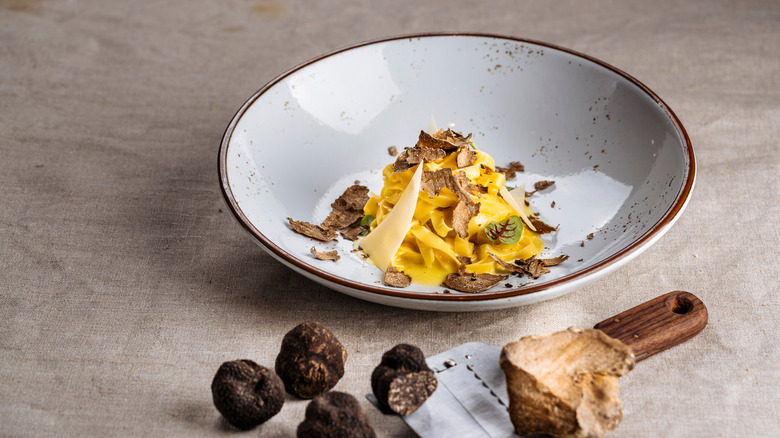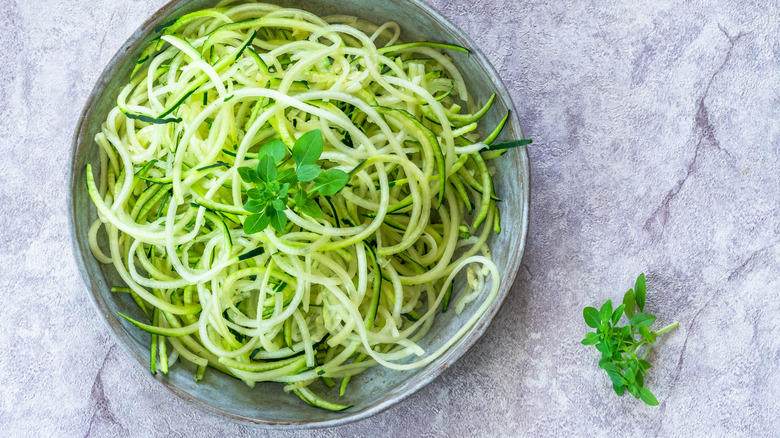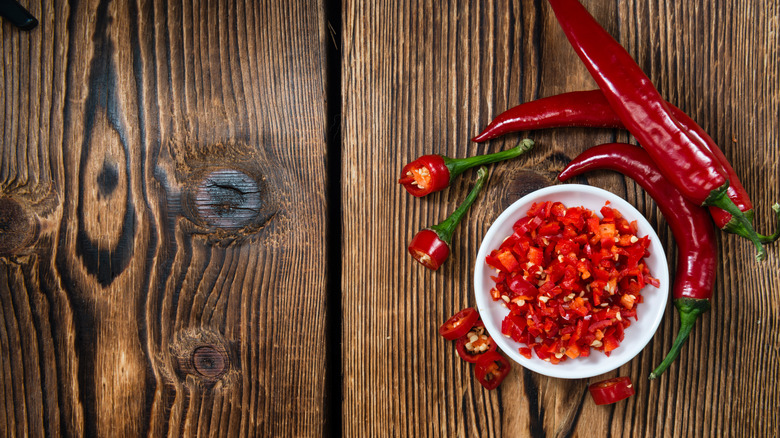10 Unexpected Ways To Upgrade Your Next Alfredo Sauce
Alfredo sauce, the rich and creamy sauce that has become a staple of Italian cuisine, is a story of simplicity, authenticity, and a dash of luck. Originating in Rome, Italy, during the early 20th century, the creamy, cheesy pasta dish was created by a chef named Alfredo di Lellio, per Forbes. He was looking to prepare an entrée for his wife who had lost her appetite. Swirling fettuccine noodles with a simple sauce made from butter, Parmesan cheese, and heavy cream, turned out to not only satisfy hunger but became a world class dish.
Despite the plate's humble beginnings and simple origins, it wasn't long before the recipe caught the attention of tourists and found its way back to the United States. Over time, American chefs started putting their own spin on the classic recipe, adding all sorts of ingredients from egg yolks to chicken broth. The result was many new versions of the creamy sauce. The Italian-American dish became one of the most beloved and widely recognized sauces in the world. From high-end restaurants to family kitchens, Alfredo sauce continues to be a crowd-pleaser and a timeless classic for topping a variety of pastas. While it may be perfect as is, what if we told you there are 10 ways you could upgrade your next Alfredo sauce to give the classic meal an unexpected twist. Not only will these upgrades add new flavors and textures to your sauce, but they will also make it more nutritious.
1. Roast some black garlic
Garlic is often a staple in many pasta sauces, including the classic Alfredo sauce. For this ingredient upgrade, step aside, plain old garlic. Instead, black garlic is here to steal the show in your next Alfredo sauce. Black garlic is a relatively new ingredient that has taken the culinary world by storm, and for good reason. The dark, sweet, and slightly tangy element is made by slowly fermenting raw garlic over several weeks, resulting in a rich, umami flavor that results in a taste nothing like the garlic we know and love. And when it comes to combining the aged cloves into Alfredo sauce, it's a total game-changer. They taste delicious and are packed with antioxidants linked to a host of health benefits.
You can elevate the flavor profile of the rich, creamy sauce with sweetness by using just a few chopped or pressed cloves. And the best part? It's surprisingly easy to add it to a traditional Alfredo sauce recipe. Simply fold the minced cloves in with the sauce and noodles. It doesn't take much black garlic to transform the delicate ingredients. The fermented flavor bomb packs a punch of garlic flavor so adjust to taste. For even more added flavor, consider roasting black garlic in the oven before incorporating it into the sauce. Place some cloves in tightly wrapped aluminum foil for about 30 minutes. The black garlic cloves will caramelize, thus bringing out a sweet, nutty flavor.
2. Add a dash of pesto
There's a new flavor to add to Alfredo sauce and it's coming in hot and green. Pesto, another classic Italian sauce, is a splendid addition to add to this classic creamy mixture. The herbaceous flavor and fresh ingredients of the pesto are perfect for cutting through the richness of Alfredo sauce. This unlikely duo is ideal for freshly made or left over Alfredo.
First off, what is pesto? Basil pesto is a bright green blend of basil, pine nuts, oil, grated Parmesan cheese, salt, pepper, and garlic. Whether you're looking for the convenience of store-bought or the satisfaction of making your own, there are plenty of options for finding the best basil out there.
Many grocery store chains carry a variety of brands, including classic recipes, as well as other variations like sun-dried tomato and spinach. Be sure to check the ingredients list for added preservatives or flavorings you may want to avoid. If you are searching for a more authentic option, specialty food stores and Italian markets may carry a wider variety of imported basil pesto that is made with traditional ingredients. For the DIY crowd, making your own is a breeze. Just combine the traditional ingredients of Parmesan cheese, pine nuts, basil, and seasonings into a food processor with some oil until well mixed. By heating and combining equal parts pesto and Alfredo sauce in a pan, you can bring this hybrid sauce to life in a matter of minutes.
3. Stir in caramelized onions
Caramelized onions and Alfredo sauce are two flavors that seem worlds apart, but when combined, they create a decadent taste experience that you won't soon forget. The cooked onions introduce a mildly sweet flavor to the otherwise dense sauce. First, prepare your Alfredo sauce and have it ready to go. You can make this from scratch by whisking together the basic recipe ingredients. Alternatively, you can also opt to use store-bought sauce, but be sure to heat it up in a separate pan before combining it with the cooked onions.
To make this delicious combination, you will have to caramelize the onions next in a separate sauté pan. The best type of onions to use for this adding to Alfredo are sweet ones, such as Vidalia, Walla Walla, or Maui onions (via Sweet Onions). While this process may seem pretty straightforward, it can easily go astray. Begin by placing thinly sliced onions in a heated skillet. The cooking time can take anywhere from 15 to 30 minutes, so patience is key, and stir the onions frequently to keep from burning. To enhance your cooked onions flavor and speed up the caramelizing process, feel free to sprinkle in some sugar (via MasterClass). Once the caramelized onions are translucent and the Alfredo sauce is ready, it's time to combine them. You can do this by simply spooning the caramelized onions over the creamy pasta by the spoonful as a topping. Another option is you can mix the sauce and onions together until well combined before incorporating the noodles. The end result is a decadent combination, perfect for a weeknight dinner.
4. Place some prosciutto on top
While you are making sure the pasta doesn't overcook and the Alfredo sauce is thickening, you can begin to focus on incorporating this next ingredient upgrade: Prosciutto. It is a type of dry-cured ham that has a long and rich history rooted in Italian heritage. The origins of the cured meat can be traced back to ancient Rome where it was a staple food. Over time, the art of making prosciutto spread throughout Italy and became an integral part of the country's cuisine. The word itself comes from the Italian word "prosciugare," which means "to dry." The process of making prosciutto involves salting the ham and hanging it to dry for several months, a method that has remained virtually unchanged for centuries. The end result is a ham that is rich, salty, and slightly sweet, with a unique flavor that is distinct from any other type of cured meat, according to Science of Cooking.
While this meat is meant to be consumed raw, you can easily incorporate it into your cooking. It's best to slice the prosciutto into thin strips and set it aside. You can also purchase it already sliced in this way if you prefer a little convenience with your cooking. Once your pasta is cooked to al dente and drained, add it to the pan with the Alfredo sauce and toss it until well coated. Now, it's time to add the prosciutto. You can easily garnish the pasta by sprinkling it over the top of the finished dish or by mixing it in the sauce directly.
5. Sprinkle in fresh herbs and greens
While Alfredo sauce is absolutely delicious on its own, adding fresh herbs to the mixture can quickly elevate it, giving the basic plate a burst of new flavor and crisp color. So if you find yourself getting a bit bored with the traditional dish, consider adding an organic touch of fresh ingredients. Most people think of herbs as the cherry on top but a handful can just as easily be blended into meals.
Some foods just taste better when combined with fresh ingredients, and when it comes to which herbs to add to the Alfredo sauce, the possibilities are boundless. For instance, thyme, basil, oregano, and parsley are a few herbs that pair perfectly with the cheesy sauce. Thyme provides a subtle, earthly flavor that balances the richness, while basil adds a fresh, herbal taste. Oregano, on the other hand, adds a touch of spice and warmth, while parsley brings a peppery pop.
When it comes to preparing fresh ingredients, chop with care. Chef Gordon Ramsey is definitely a chef with the experience to demonstrate the best ways to cut fresh herbs. Start by rolling basil before finely chopping to prevent bruising any of the delicate greens. Bruised herbs release their essential oils, causing the ingredient to lose the aromas and flavors necessary for a fresh taste. This not only affects the appearance of the herb, but it also affects the flavor of your final dish. It's also best to avoid using dull cutlery. A sharp knife is essential, as is precise cutting motions and a consistent pace.
6. Include chopped pancetta
Alfredo sauce, a classic, rich pasta sauce, has been a staple in Italian cuisine for generations. But let's face it, sometimes even the classics get old and require a little spicing up. Upgrade your next Alfredo recipe with an unforgettable protein. It's hard to imagine a world without this salty, slightly spicy, cured meat. From ancient Rome to your dinner table, pancetta is yet another popular Italian ingredient you can use to upgrade the buttery, smooth sauce.
Pancetta is a type of Italian bacon that is cured with salt and spices, giving it a very unique flavor profile. It is made from pork belly and is similar tasting to bacon in that it delivers a bold smokey flavor to any dish it's combined with, yet it's unsmoked. First cook the chopped pancetta in a skillet until it's crispy and golden brown. Once it's ready, remove it from the heat and let it rest on a separate dish while you prepare the rest of the meal. The meat needs time to cool before it's combined with the cheese sauce.
But the benefits of adding pancetta to your Alfredo sauce go beyond just taste. Pancetta is also a time-saver, allowing you to simplify your recipe without sacrificing flavor. Instead of sautéing onions, garlic, and other ingredients, you can simply add chopped pancetta to your sauce and let its flavor do the work. With its unique taste and texture, it may just be the upgrade to try in your Alfredo sauce tonight.
7. Splurge on adding truffles
If you are searching for a way to add a touch of sophistication to your Alfredo sauce in a bold and unexpected way, than consider cooking with truffles. This ingredient, a type of edible fungus, is known for its distinct aroma and luxurious depth of flavor. While potentially hard to source and brings with it a hefty price tag, they are still a highly coveted ingredient. Truffles are often found in wild, forested areas at the base area of trees, near the roots. They are sought after by foodies and gourmands worldwide, and for good reason. This harvested ingredient has the power to transform any dish with grace, elevating the taste and texture. When incorporated correctly, the velvety texture of the truffles blends seamlessly with the creamy cheese sauce.
According to English Truffles, if you do choose to cook with this ingredient, it's suggested not to cook them too long over any intense level of heat. While warming them is perfectly fine, overcooking this delicate ingredient will cause it to lose its luster and flavor. However, they don't require any cooking in order to eat them. Shaved truffles can be used as is to garnish the top of the pasta plate once it's ready to be served. This is ideal when cooking hot dishes like Alfredo sauce, as truffles are normally sliced thinly. You can also opt to use truffle oil, which will add a similar rich flavor without the hassle of slicing truffles. It's also a lot easier to source and potentially cheaper, too.
8. Mix in tricolor cherry tomatoes
If you are looking for a way to brighten up this indulgent dish, consider cutting some of the intense richness of the heavy ingredients with a bit of natural acidity. Tricolor cherry tomatoes are a stellar addition to include in Alfredo sauce, as they deliver a slightly bitter taste that can help balance the other flavors. These tomatoes, as the name suggests, come in a range of vibrant colors, including red, yellow, orange, and green. They are incredibly versatile, making them an easy favorite in kitchens everywhere. The complete medley of tomatoes is not just for feasting on with the eyes, each variety also delivers its very own unique taste to the dish.
When the bite sized tomatoes are added to Alfredo sauce, they not only bring a touch of color to the dish, but also add a tangy, slightly sweet flavor that complements the thick sauce. Tricolor cherry tomatoes are beautiful but they also exhibit a much milder taste, perfect for those looking for less tomato flavor in the dish, according to Secret Seed Cartel. What sets this variety of tomatoes apart from other types is their subtle sweetness and juiciness. The best part about adding these small round tomatoes to your Alfredo sauce is that the process is quick, easy, and requires absolutely no cooking. Simply half the tomatoes and stir the cut pieces into the sauce, and voila! Your Alfredo has been transformed into a dish fit for a summer's day.
9. Shred some zucchini
When it comes to eating Alfredo sauce, let's be real, we all know it's not exactly a healthy dish. It doesn't matter if it's freshly made or right out of the jar. But what if we told you there was a way for you to get a daily dose of healthy greens into your indulgent cheese sauce next time you make it? Enter shredded zucchini. Also known as a courgette, zucchini is a low-carb, low-sugar vegetable packed with a host of beneficial nutrients that's easy to incorporate with a creamy mixture as it adds little to no flavor (via USDA). This summer squash is a versatile veggie that is not only pleasing to the palette but even a favorite for those less inclined to consume nutritious produce.
Adding this vegetable to your next batch of Alfredo sauce is incredibly easy. Start by shredding around one or two medium sized zucchini into thin strips before stirring them into the Alfredo mixture, cooking until it's heated through. The strips of zucchini will cook down in the sauce and almost disappear, adding those extra nutrients without sacrificing the taste of the dish. You know it's ready when the veggie is tender, and soft but still retains its form. Another indicator of readiness is the color of the vegetable. The zucchini will change from a brighter shade of green to a more muted hue. Zucchini is a great source of vitamins and minerals, and a perfect component for adding volume to the dish as well.
10. Kick it up a notch with chili peppers
If you like it "hot," consider adding a bit of spice as the upgrade in your next sauce. Chili peppers are a fiery addition to any dish, and when it comes to Alfredo sauce they bring a whole new level of excitement to the table. While this classic, creamy sauce is known for its rich and indulgent flavor, with a little bit of heat, it becomes a tantalizing treat. The peppers will certainly give the dish an intense flavor boost, but it's important to be mindful of the peppers' heat level. Chili peppers' heat actually comes from a chemical called capsaicin (via Chili Pepper Madness). This compound is what makes our mouths feel hot, and it's why these peppers are a staple in so many cultures around the world. Capsaicin stimulates the release of endorphins, the body's natural painkillers, making us feel more alert and awake.
How do you add these fiery little nuggets of flavor to your sauce? According to Harvest To Table, peppers can be seared, grilled, roasted, toasted, or served raw. For a slightly charred taste, place them on a hot grill for a few minutes, toss them in a skillet with a little bit of oil, or on sliced and set on a pan for roasting in the oven. No matter which method you choose, it will certainly upgrade the traditional Italian entrée. You can always customize the dish to fit your heat preferences so it's perfect each and every time.
